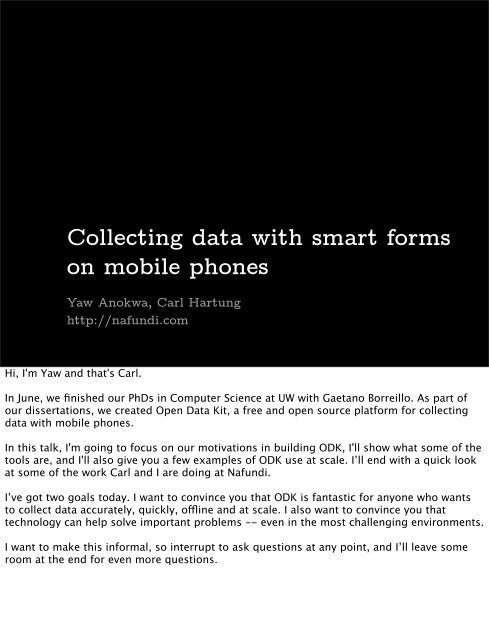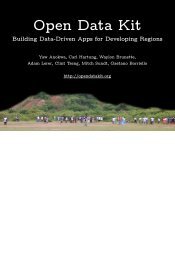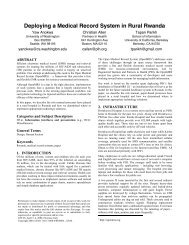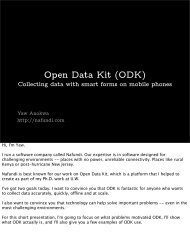Collecting data with smart forms on mobile phones - Yaw Anokwa
Collecting data with smart forms on mobile phones - Yaw Anokwa
Collecting data with smart forms on mobile phones - Yaw Anokwa
Create successful ePaper yourself
Turn your PDF publications into a flip-book with our unique Google optimized e-Paper software.
<str<strong>on</strong>g>Collecting</str<strong>on</strong>g> <str<strong>on</strong>g>data</str<strong>on</strong>g> <str<strong>on</strong>g>with</str<strong>on</strong>g> <str<strong>on</strong>g>smart</str<strong>on</strong>g> <str<strong>on</strong>g>forms</str<strong>on</strong>g><br />
<strong>on</strong> <strong>mobile</strong> ph<strong>on</strong>es<br />
<strong>Yaw</strong> <strong>Anokwa</strong>, Carl Hartung<br />
http://nafundi.com<br />
Hi, I'm <strong>Yaw</strong> and that's Carl.<br />
In June, we finished our PhDs in Computer Science at UW <str<strong>on</strong>g>with</str<strong>on</strong>g> Gaetano Borreillo. As part of<br />
our dissertati<strong>on</strong>s, we created Open Data Kit, a free and open source platform for collecting<br />
<str<strong>on</strong>g>data</str<strong>on</strong>g> <str<strong>on</strong>g>with</str<strong>on</strong>g> <strong>mobile</strong> ph<strong>on</strong>es.<br />
In this talk, I'm going to focus <strong>on</strong> our motivati<strong>on</strong>s in building ODK, I'll show what some of the<br />
tools are, and I'll also give you a few examples of ODK use at scale. I’ll end <str<strong>on</strong>g>with</str<strong>on</strong>g> a quick look<br />
at some of the work Carl and I are doing at Nafundi.<br />
I’ve got two goals today. I want to c<strong>on</strong>vince you that ODK is fantastic for any<strong>on</strong>e who wants<br />
to collect <str<strong>on</strong>g>data</str<strong>on</strong>g> accurately, quickly, offline and at scale. I also want to c<strong>on</strong>vince you that<br />
technology can help solve important problems -- even in the most challenging envir<strong>on</strong>ments.<br />
I want to make this informal, so interrupt to ask questi<strong>on</strong>s at any point, and I’ll leave some<br />
room at the end for even more questi<strong>on</strong>s.
<str<strong>on</strong>g>Collecting</str<strong>on</strong>g> <str<strong>on</strong>g>data</str<strong>on</strong>g> in low-income regi<strong>on</strong>s is difficult.<br />
This picture is a village we worked in <strong>on</strong> the edge of Lake Victoria in Eastern Uganda, and I<br />
think it’s an example of the places where organizati<strong>on</strong>s like PATH need to collect <str<strong>on</strong>g>data</str<strong>on</strong>g>.<br />
You can see in a place like this there is almost no infrastructure to enable communicati<strong>on</strong><br />
<str<strong>on</strong>g>with</str<strong>on</strong>g> the rest of the world. There's no electricity, there's actually no wired infrastructure of any<br />
kind.<br />
For those of you who have traveled to a developing country, we didn't see any Coca Cola for<br />
sale, which is the <strong>on</strong>e thing you can usually find anywhere in the world. So that's how you<br />
know when you've really left the map.<br />
So how do you collect <str<strong>on</strong>g>data</str<strong>on</strong>g> in a place like this?
Paper is comm<strong>on</strong>, but can be very limiting.<br />
You probably use paper, but that can be very limiting.<br />
Hard to be accurate. You get plenty of handwriting and transcripti<strong>on</strong> mistakes.<br />
Hard to have complex questi<strong>on</strong>s. You want to ask different questi<strong>on</strong>s based <strong>on</strong> previous<br />
answers, but that’s hard to train for.<br />
Hard to capture things like locati<strong>on</strong>, multimedia. Adding a GPS and camera adds more points<br />
of failure. How will you attach it to the paper record to you can use it in the analysis?<br />
Hard to get the <str<strong>on</strong>g>data</str<strong>on</strong>g> in quickly. It’s really important to have <str<strong>on</strong>g>data</str<strong>on</strong>g> as it comes in so you know<br />
when there are problems. You d<strong>on</strong>’t want to wait a few m<strong>on</strong>ths after the study is d<strong>on</strong>e to<br />
know something went wr<strong>on</strong>g.<br />
We saw these problems a lot in the field, and so that was the driving motivati<strong>on</strong> behind our<br />
work -- addressing these limitati<strong>on</strong>s through technology. That’s why we created ODK.
ODK uses ph<strong>on</strong>es and servers to digitize <str<strong>on</strong>g>data</str<strong>on</strong>g> collecti<strong>on</strong>.<br />
1. Build form 2. Collect <str<strong>on</strong>g>data</str<strong>on</strong>g> 3. Aggregate results<br />
ODK is a free and open-source set of tools which use <str<strong>on</strong>g>smart</str<strong>on</strong>g>ph<strong>on</strong>es and cloud servers to<br />
digitize <str<strong>on</strong>g>data</str<strong>on</strong>g> collecti<strong>on</strong>.<br />
It's great for field staff who need to collect <str<strong>on</strong>g>data</str<strong>on</strong>g> accurately, quickly, offline and at scale. ODK<br />
can be used to implement large socio-ec<strong>on</strong>omic surveys, collect geo-tagged vaccine <str<strong>on</strong>g>data</str<strong>on</strong>g>, or<br />
even triage patients <str<strong>on</strong>g>with</str<strong>on</strong>g> complex decisi<strong>on</strong> trees and embedded videos.<br />
ODK provides an out-of-the-box soluti<strong>on</strong> for users to:<br />
1. Build a <str<strong>on</strong>g>data</str<strong>on</strong>g> collecti<strong>on</strong> form or survey;<br />
2. Collect the <str<strong>on</strong>g>data</str<strong>on</strong>g> <strong>on</strong> a <strong>mobile</strong> device and send it to a server; and<br />
3. Aggregate the collected <str<strong>on</strong>g>data</str<strong>on</strong>g> <strong>on</strong> a server and extract it in useful formats.<br />
If there is <strong>on</strong>e thing to take away from the talk this is it. If you were planning <strong>on</strong> taking a nap<br />
during the talk, you may now do so guilt-free.<br />
Anyway, so what are these tools that you use to Build, Collect and Aggregate?
Build: Drag and drop prompts for form creati<strong>on</strong>.<br />
ODK Build is an web applicati<strong>on</strong> where you drag and drop prompts to create <str<strong>on</strong>g>forms</str<strong>on</strong>g>. It runs in<br />
the browser but can also be used offline. It looks like this.<br />
*<br />
To design a form, you drag and drop each prompt the user will interact <str<strong>on</strong>g>with</str<strong>on</strong>g> from this butt<strong>on</strong><br />
pane<br />
*<br />
to the canvas. Each prompt has a set of properties which users can edit here.<br />
*<br />
The prompts are pretty powerful. For example, you can have multiple languages for each<br />
prompt, make prompts relevant based <strong>on</strong> previous answers, or make prompts loop some<br />
number of times.<br />
When you are d<strong>on</strong>e, thats what goes to the ph<strong>on</strong>e.
Collect: Display prompts for <str<strong>on</strong>g>data</str<strong>on</strong>g> collecti<strong>on</strong> and delivery.<br />
ODK Collect is an app that display prompts to collect and deliver different types of <str<strong>on</strong>g>data</str<strong>on</strong>g>.<br />
Collect runs <strong>on</strong> the Android operating system so you can use it <strong>on</strong> ph<strong>on</strong>es, tablets and<br />
netbooks. It runs great offline and looks like this.<br />
*<br />
You can collect text, numbers<br />
*<br />
dates<br />
*<br />
you can put c<strong>on</strong>straints <strong>on</strong> all prompts. So for example, birth dates can’t be in the future.<br />
*<br />
You can also capture GPS locati<strong>on</strong> using <strong>on</strong>e click.
Collect: Display prompts for <str<strong>on</strong>g>data</str<strong>on</strong>g> collecti<strong>on</strong> and delivery.<br />
The <str<strong>on</strong>g>forms</str<strong>on</strong>g> themselves are really powerful. So here is an example of IMCI in swahili.<br />
IMCI is the integrated management of childhood illnesses. It’s basically a triage protocol for<br />
children under five.<br />
My Swahili is weak, so let’s switch to English. With ODK Collect you can do this <strong>on</strong> the fly.<br />
And if I enter that the child is coughing and has a fever, in the next screen, I can record the<br />
sound of the cough and then I can show the mother a video about how to treat fever.<br />
So there is this collecti<strong>on</strong> of <str<strong>on</strong>g>data</str<strong>on</strong>g>, but also a delivery of informati<strong>on</strong> using complex logic. Any<br />
<str<strong>on</strong>g>data</str<strong>on</strong>g> I gather can be stored offline and then be sent off to a server.<br />
So that’s ODK Collect. And where does the <str<strong>on</strong>g>data</str<strong>on</strong>g> go?
Aggregate: Host <str<strong>on</strong>g>data</str<strong>on</strong>g> and provide extracti<strong>on</strong> interfaces.<br />
Aggregate hosts the submitted <str<strong>on</strong>g>data</str<strong>on</strong>g> and provides interfaces such as<br />
spreadsheets, maps, and queries. We d<strong>on</strong>’t run <strong>on</strong>e big server, you download an installer, and<br />
it c<strong>on</strong>figures <strong>on</strong>e just for your organizati<strong>on</strong>.
Aggregate: Stores or forwards <str<strong>on</strong>g>data</str<strong>on</strong>g> to external systems.<br />
Finally, Aggregate can either store or stream your <str<strong>on</strong>g>data</str<strong>on</strong>g> to other systems, like Google Earth.<br />
In this example, forestry workers <str<strong>on</strong>g>with</str<strong>on</strong>g> the Jane Goodall Institute in Tanzania, submitted <str<strong>on</strong>g>data</str<strong>on</strong>g><br />
from Collect to Aggregate and then exported to Google Earth<br />
Managers could then click <strong>on</strong> each yellow point and get the <str<strong>on</strong>g>data</str<strong>on</strong>g> that was submitted.
1. Build form 2. Collect <str<strong>on</strong>g>data</str<strong>on</strong>g> 3. Aggregate results<br />
So that’s what ODK is. A platform that will help you build a form, collect <str<strong>on</strong>g>data</str<strong>on</strong>g>, and aggregate<br />
some results.<br />
For building <str<strong>on</strong>g>forms</str<strong>on</strong>g>, you can use Excel. For aggregate <str<strong>on</strong>g>data</str<strong>on</strong>g>, we have a desktop app for that<br />
too. You pick and choose which work best for your use case.<br />
Now that’s nice and all, but when people find out that this came out of a research project,<br />
they start asking if the software actually works.<br />
Well, yeah! Let me give you some examples.
Kiva uses ODK to get borrower informati<strong>on</strong>.
Carter Center uses ODK for m<strong>on</strong>itoring electi<strong>on</strong>s.
Carb<strong>on</strong> For Water collected over 1,000,000 <str<strong>on</strong>g>forms</str<strong>on</strong>g><br />
<str<strong>on</strong>g>with</str<strong>on</strong>g> 4,000 ODK-powered ph<strong>on</strong>es in 6 weeks.<br />
Carb<strong>on</strong> For Water wanted to distributes LifeStraw Family water treatment units to 4 milli<strong>on</strong><br />
people. And as part of that distributi<strong>on</strong> they want to take images and locati<strong>on</strong> of each<br />
barcoded unit, al<strong>on</strong>g <str<strong>on</strong>g>with</str<strong>on</strong>g> some socio-ec<strong>on</strong>omic <str<strong>on</strong>g>data</str<strong>on</strong>g>.<br />
And so they used 4,000 ODK-enabled ph<strong>on</strong>es to collect over a milli<strong>on</strong> <str<strong>on</strong>g>forms</str<strong>on</strong>g> in six weeks.<br />
Which is incredible.<br />
They’ve found that ODK enables real-time collecti<strong>on</strong> of image, GPS and survey <str<strong>on</strong>g>data</str<strong>on</strong>g> at scale.<br />
Actually, it’s kind of scary because they told us about the deployment after it happened. They<br />
just took the software and ran <str<strong>on</strong>g>with</str<strong>on</strong>g> it. My jaw dropped when I saw those numbers. Our<br />
largest deployment before that was a couple of hundred ph<strong>on</strong>es.
AMPATH’s health workers have used ODK to<br />
counsel and test over 650,000 people for HIV.<br />
AMPATH is <strong>on</strong>e of the largest HIV treatment programs in Africa. They have about 2 milli<strong>on</strong><br />
people in their catchment area and are treating 130k HIV positive people.<br />
As part of their care, they have 300 community health workers who go house to house and do<br />
home-based counseling and testing for HIV. These guys are equipped <str<strong>on</strong>g>with</str<strong>on</strong>g> ODK-powered<br />
<str<strong>on</strong>g>smart</str<strong>on</strong>g>ph<strong>on</strong>es.<br />
This image shows <strong>on</strong>e of those workers using the barcode scanner <strong>on</strong> the ph<strong>on</strong>e to identify a<br />
patient.<br />
We helped these guys pilot the system for two weeks, then they took over. The project started<br />
in early 2010 and as of a few m<strong>on</strong>ths they had visited 650k individuals.<br />
Users found the system easy to use and thought it allowed them to collect higher quality <str<strong>on</strong>g>data</str<strong>on</strong>g>.<br />
Supervisors saw higher cost savings over their previous PDA-based system as well as over pen<br />
and paper systems.<br />
Electr<strong>on</strong>ic collecti<strong>on</strong> also facilitated earlier reporting, which means more people get <strong>on</strong><br />
treatment much faster.
I want to use RHVouchers as a last example.<br />
A reproductive health voucher is a card that entitles a poor, pregnant woman to subsidized<br />
maternity care. These vouchers are used around the world, but do they actually help improve<br />
the quality of care?<br />
The Populati<strong>on</strong> Council and Marie Stopes are evaluating voucher programs in Kenya, Uganda,<br />
Tanzania, Bangladesh and Cambodia to find out.<br />
As <strong>on</strong>e could expect, these evaluati<strong>on</strong>s are an intensive process of collecting, organizing,<br />
cleaning, and analyzing <str<strong>on</strong>g>data</str<strong>on</strong>g>.<br />
The process happens over largely rural areas <str<strong>on</strong>g>with</str<strong>on</strong>g> vast distances between households and<br />
health service providers and these guys put together a video about how they use ODK.
Growing number of companies around the platform.<br />
ODK is more than some code and a mailing list. The project is a community and we’ve spent<br />
a lot of time investing and growing in that community and it’s paid off.<br />
There are companies that build entire products around ODK. There are also a lot of<br />
c<strong>on</strong>sulting companies around the platform -- a lot of them in developing countries.
And now that Carl and I have graduated, we’ve jumped into the fray <str<strong>on</strong>g>with</str<strong>on</strong>g> Nafundi.<br />
Nafundi is a word that has its roots in Swahili. Loosely translated, it means "<str<strong>on</strong>g>with</str<strong>on</strong>g> a<br />
craftsman," and that idea describes the skilled and collaborative we when building software.<br />
Nafundi is a software c<strong>on</strong>sulting company. We write code for hire.<br />
A large part of what we do is provide services around ODK. When we where at UW, we were<br />
focused <strong>on</strong> computer science research and that’s not always immediately useful to our users.<br />
Now that we are at Nafundi, we can focus <strong>on</strong> more what implementers need day to day --<br />
everything from helping you make your survey, building extensi<strong>on</strong>s to ODK, helping you train<br />
and scale, etc.<br />
We also build custom software that will work well in challenging envir<strong>on</strong>ments -- places <str<strong>on</strong>g>with</str<strong>on</strong>g><br />
unreliable c<strong>on</strong>nectivity, novice users, etc. It turns out our experience <strong>on</strong> ODK helps us build<br />
software that just works.<br />
For example, we are working <str<strong>on</strong>g>with</str<strong>on</strong>g> IHME to build a desktop program that makes it easy for incountry<br />
researchers to automatically figure out the cause of death from verbal autopsy <str<strong>on</strong>g>data</str<strong>on</strong>g>.<br />
So again, it’s custom software development, but for places where normal software shops<br />
d<strong>on</strong>’t have any experience.
<str<strong>on</strong>g>Collecting</str<strong>on</strong>g> <str<strong>on</strong>g>data</str<strong>on</strong>g> accurately and quickly <strong>on</strong> paper is difficult.<br />
ODK uses ph<strong>on</strong>es and servers to digitize <str<strong>on</strong>g>data</str<strong>on</strong>g> collecti<strong>on</strong>.<br />
1. Build form 2. Collect <str<strong>on</strong>g>data</str<strong>on</strong>g> 3. Aggregate results<br />
http://open<str<strong>on</strong>g>data</str<strong>on</strong>g>kit.org (@open<str<strong>on</strong>g>data</str<strong>on</strong>g>kit)<br />
http://nafundi.com (@nafundi)<br />
http://anokwa.com (@yanokwa)<br />
Using paper to collect <str<strong>on</strong>g>data</str<strong>on</strong>g> is difficult and inefficient. ODK is a free and open-source set of<br />
tools which use <str<strong>on</strong>g>smart</str<strong>on</strong>g>ph<strong>on</strong>es and cloud servers to digitize <str<strong>on</strong>g>data</str<strong>on</strong>g> collecti<strong>on</strong>.<br />
ODK provides an out-of-the-box soluti<strong>on</strong> for users to:<br />
1. Build a <str<strong>on</strong>g>data</str<strong>on</strong>g> collecti<strong>on</strong> form or survey;<br />
2. Collect the <str<strong>on</strong>g>data</str<strong>on</strong>g> <strong>on</strong> a <strong>mobile</strong> device and send it to a server; and<br />
3. Aggregate the collected <str<strong>on</strong>g>data</str<strong>on</strong>g> <strong>on</strong> a server and extract it in useful formats.<br />
Are there are any questi<strong>on</strong>s I could answer?





